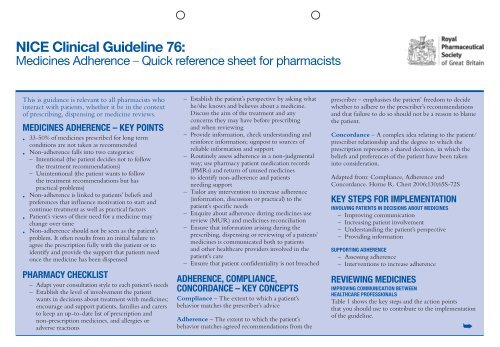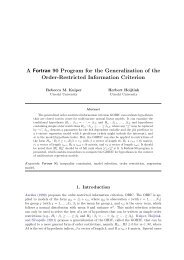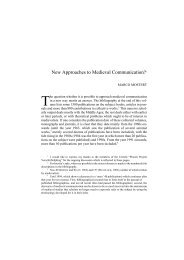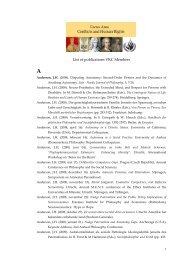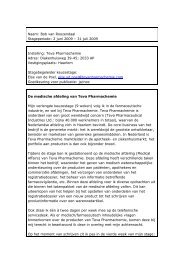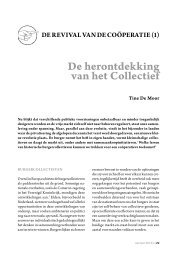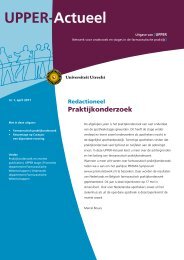Medicines adherence, quick reference sheet for pharmacists
Medicines adherence, quick reference sheet for pharmacists
Medicines adherence, quick reference sheet for pharmacists
You also want an ePaper? Increase the reach of your titles
YUMPU automatically turns print PDFs into web optimized ePapers that Google loves.
NICE Clinical Guideline 76:<br />
<strong>Medicines</strong> Adherence – Quick <strong>reference</strong> <strong>sheet</strong> <strong>for</strong> <strong>pharmacists</strong><br />
This is guidance is relevant to all <strong>pharmacists</strong> who<br />
interact with patients, whether it be in the context<br />
of prescribing, dispensing or medicine reviews.<br />
<strong>Medicines</strong> <strong>adherence</strong> – key points<br />
• 33-50% of medicines prescribed <strong>for</strong> long term<br />
conditions are not taken as recommended<br />
• Non-<strong>adherence</strong> falls into two categories:<br />
– Intentional (the patient decides not to follow<br />
the treatment recommendations)<br />
– Unintentional (the patient wants to follow<br />
the treatment recommendations but has<br />
practical problems)<br />
• Non-<strong>adherence</strong> is linked to patients’ beliefs and<br />
p<strong>reference</strong>s that influence motivation to start and<br />
continue treatment as well as practical factors<br />
• Patient’s views of their need <strong>for</strong> a medicine may<br />
change over time<br />
• Non-<strong>adherence</strong> should not be seen as the patient’s<br />
problem. It often results from an initial failure to<br />
agree the prescription fully with the patient or to<br />
identify and provide the support that patients need<br />
once the medicine has been dispensed<br />
Pharmacy checklist<br />
– Adapt your consultation style to each patient’s needs<br />
– Establish the level of involvement the patient<br />
wants in decisions about treatment with medicines;<br />
encourage and support patients, families and carers<br />
to keep an up-to-date list of prescription and<br />
non-prescription medicines, and allergies or<br />
adverse reactions<br />
– Establish the patient’s perspective by asking what<br />
he/she knows and believes about a medicine.<br />
Discuss the aim of the treatment and any<br />
concerns they may have be<strong>for</strong>e prescribing<br />
and when reviewing<br />
– Provide in<strong>for</strong>mation, check understanding and<br />
rein<strong>for</strong>ce in<strong>for</strong>mation; signpost to sources of<br />
reliable in<strong>for</strong>mation and support<br />
– Routinely assess <strong>adherence</strong> in a non-judgmental<br />
way; use pharmacy patient medication records<br />
(PMRs) and return of unused medicines<br />
to identify non-<strong>adherence</strong> and patients<br />
needing support<br />
– Tailor any intervention to increase <strong>adherence</strong><br />
(in<strong>for</strong>mation, discussion or practical) to the<br />
patient’s specific needs<br />
– Enquire about <strong>adherence</strong> during medicines use<br />
review (MUR) and medicines reconciliation<br />
– Ensure that in<strong>for</strong>mation arising during the<br />
prescribing, dispensing or reviewing of a patients’<br />
medicines is communicated both to patients<br />
and other healthcare providers involved in the<br />
patient’s care<br />
– Ensure that patient confidentiality is not breached<br />
Adherence, compliance,<br />
concordance – key concepts<br />
Compliance – The extent to which a patient’s<br />
behavior matches the prescriber’s advice<br />
Adherence – The extent to which the patient’s<br />
behavior matches agreed recommendations from the<br />
prescriber – emphasises the patient’ freedom to decide<br />
whether to adhere to the prescriber’s recommendations<br />
and that failure to do so should not be a reason to blame<br />
the patient.<br />
Concordance – A complex idea relating to the patient/<br />
prescriber relationship and the degree to which the<br />
prescription represents a shared decision, in which the<br />
beliefs and p<strong>reference</strong>s of the patient have been taken<br />
into consideration.<br />
Adapted from: Compliance, Adherence and<br />
Concordance. Horne R. Chest 2006;130;65S-72S<br />
Key steps <strong>for</strong> implementation<br />
Involving patients in decisions about medicines<br />
– Improving communication<br />
– Increasing patient involvement<br />
– Understanding the patient’s perspective<br />
– Providing in<strong>for</strong>mation<br />
Supporting <strong>adherence</strong><br />
– Assessing <strong>adherence</strong><br />
– Interventions to increase <strong>adherence</strong><br />
Reviewing medicines<br />
Improving communication between<br />
healthcare professionals<br />
Table 1 shows the key steps and the action points<br />
that you should use to contribute to the implementation<br />
of the guideline.<br />
➥
Table 1: Implementation measures<br />
and action points <strong>for</strong> <strong>pharmacists</strong><br />
Involving patients in decisions about medicines<br />
Improving communication<br />
Adapt your consultation style to each patient’s needs<br />
• Consider any factors or disabilities which may affect patient<br />
involvement in the consultation<br />
• Establish the best way to communicate with each patient<br />
(consider the use of pictures, large print, in<strong>for</strong>mation in different<br />
languages, an interpreter or advocate)<br />
• Ask open-ended questions because these are more likely to<br />
uncover concerns<br />
• Encourage patients to ask questions.<br />
Increasing patient involvement<br />
• Offer all patients the opportunity to be involved in decisions<br />
about their medicines<br />
• Explain clearly the condition and the pros and cons<br />
of treatment<br />
Clarify what the patient hopes the treatment will achieve<br />
• Talk and listen to the patient and note non-verbal cues<br />
rather than making assumptions about patients’ p<strong>reference</strong>s<br />
about treatment<br />
• Help patients to make decisions based on likely benefits<br />
and risks rather than misconceptions<br />
• Accept that:<br />
– Patients may have different views from healthcare<br />
professionals about risks, benefits and side effects<br />
– Patients have the right to decide not to take a medicine<br />
as long as they have capacity and have been given the<br />
in<strong>for</strong>mation to make an in<strong>for</strong>med decision<br />
• If the patient decides not to take a medicine and you believe<br />
this could be harmful, record the decision and the in<strong>for</strong>mation<br />
provided on risks and benefits<br />
• Encourage and support patients, families and carers to keep an<br />
up-to-date list of prescription and non-prescription medicines,<br />
and allergies or adverse reactions<br />
Understanding the patient’s perspective<br />
• Ask patients what they know, believe and understand about<br />
their medicines be<strong>for</strong>e prescribing, and when reviewing<br />
(e.g. <strong>for</strong> a MUR)<br />
• Ask about and address any concerns (such as adverse effects<br />
or dependence) when prescribing, dispensing or reviewing<br />
medicines. If the patient has specific concerns, record a<br />
summary of the discussion.<br />
• Remember – patients may wish to minimise their medicines<br />
and to discuss<br />
– What will happen if they don’t take the medicine<br />
– Non-pharmacological alternatives<br />
– Reducing or stopping long-term medicines<br />
– Fitting medicines into their routine<br />
– Choosing between medicines.<br />
Providing in<strong>for</strong>mation<br />
At the time of prescribing:<br />
• Be<strong>for</strong>e you prescribe, offer patients (including inpatients) clear<br />
relevant in<strong>for</strong>mation. This will probably include but should not<br />
be limited to:<br />
– What the medicine is, how to use it and likely benefits<br />
– Likely adverse effects and what to do if they occur<br />
– What to do if a dose is missed<br />
– Whether another prescription is needed and how to<br />
get further supplies.<br />
At the time of dispensing:<br />
Check patients have the in<strong>for</strong>mation that they wish<br />
• Check patients have understood the in<strong>for</strong>mation and discuss it<br />
with them, taking into account what they understand and<br />
believe about the condition and treatment<br />
• Do not assume that patient in<strong>for</strong>mation leaflets (PILs) will meet<br />
all patients’ needs. Address concerns raised as a result<br />
of in<strong>for</strong>mation provided by PILs.<br />
• Signpost to sources of reliable in<strong>for</strong>mation and support<br />
(e.g. NHS Choices [www.nhs.uk])<br />
Supporting <strong>adherence</strong><br />
Assessing <strong>adherence</strong><br />
• Ask patients if they have missed any doses recently; make it<br />
easier <strong>for</strong> them by:<br />
– asking in a way that does not apportion blame<br />
– explaining why you are asking<br />
– mentioning a specific time (such as in the past week)<br />
– asking about medicine-taking habits<br />
• Use records of prescription re-ordering, pharmacy patient<br />
medication records (PMRs) and return of unused medicines<br />
to identify non-<strong>adherence</strong> and patients needing support<br />
Interventions to increase <strong>adherence</strong><br />
• If a patient is not taking their medicines discuss whether this is<br />
because of beliefs and concerns (intentional non-<strong>adherence</strong>) or<br />
practical problems (unintentional non-<strong>adherence</strong>) and together<br />
consider options <strong>for</strong> support<br />
• Address any beliefs and concerns the patient has about his<br />
or her medicines<br />
• Only use interventions to overcome practical problems if there is<br />
a specific need. Interventions might include:<br />
– suggesting patients record their medicine-taking<br />
– encouraging patients to monitor their condition<br />
– simplifying the dosing regimen<br />
– using alternative packaging<br />
– using a multi-compartment medicines system (MDS)<br />
•<br />
If side effects are a problem:<br />
– discuss benefits, side effects, long-term effects and how the<br />
patient would like to deal with side effects<br />
– consider adjusting the dosage, switching to another medicine,<br />
and other strategies such as changing the timing of medicines<br />
•<br />
If prescription costs are a problem consider options to<br />
reduce costs<br />
Reviewing medicines<br />
• Offer repeat in<strong>for</strong>mation and review to patients, especially when<br />
treating long-term conditions with multiple medicines<br />
• At agreed intervals, review patients’ knowledge, understanding<br />
and concerns about their medicines and whether they think they<br />
still need them<br />
• Ask about <strong>adherence</strong>. Clarify possible causes of non-<strong>adherence</strong><br />
and agree any action with the patient (including a date <strong>for</strong><br />
follow-up)<br />
• Remember to ask if patients have their own ways of weighing<br />
up their medicines. (e.g. by stopping and starting them and<br />
monitoring symptoms).<br />
Improving communication between healthcare professionals<br />
• When reviewing medicines in<strong>for</strong>m the prescriber of the review<br />
and its outcome<br />
• Ensure there are robust processes <strong>for</strong> communicating with other<br />
healthcare professionals involved in the patient’s care<br />
• On transfer between services (<strong>for</strong> example, transfer in or out of a<br />
care home or hospital) patients and subsequent healthcare or<br />
other providers should receive a written report containing:<br />
– the patient's diagnosis<br />
– a list of all medicines the patient should be taking<br />
– details of new medicines that were started recently<br />
and the reason<br />
– details of medicines that were stopped recently<br />
with reasons<br />
– clear in<strong>for</strong>mation on which medicines should be continued<br />
after transfer and <strong>for</strong> how long<br />
– any known adverse reactions and allergies<br />
– any potential difficulties with <strong>adherence</strong> and any actions<br />
taken (e.g. if compliance aids are used or recommended)


